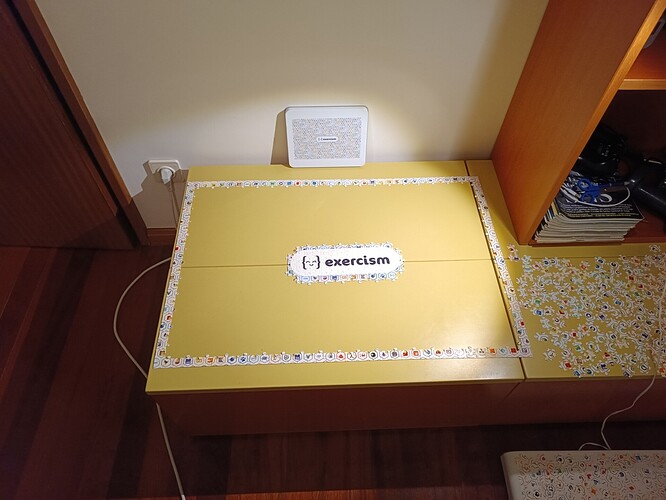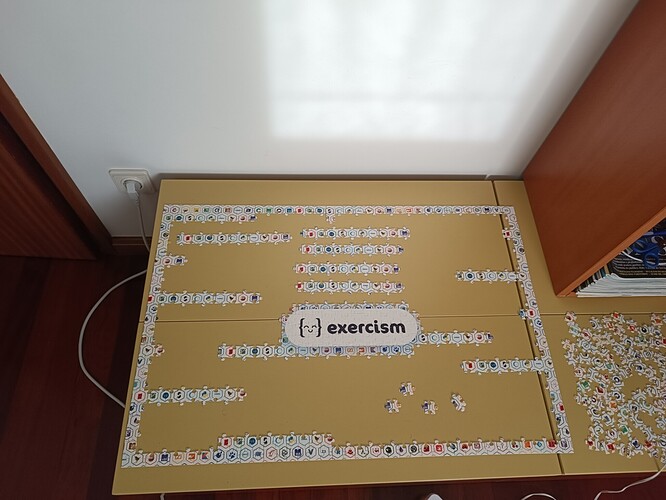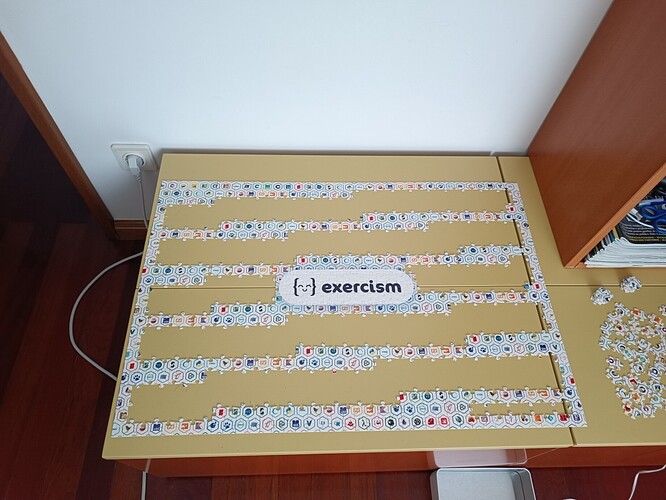My exercism swag in one picture, now also featuring the 1000-piece puzzle and the laptop sleeve.
How padded is that sleeve?
It’s the 15″ one.
Not sure if this answers your question though. As a non-native english speaker, I’m not sure what you mean by padded here.
Will it protect if dropped, or protect if something is dropped on the center? How protective is the sleeve?
Padding reffers to how thick the material is more or less.(I think, I am not native speaker aswell)
Ah, gotcha. It’s probably the thickest sleeve I had. Protects the PC very well and the material seems good.
Don’t have it with me at the moment, but I can post a more detailed picture later.
This is literally the most awesome thing I’ve ever seen in my life ![]()
I love that the jigsaw comes in its own tin.
My mother’s favorite thing to do is jigsaw puzzles! I would send one to her but she would be confused by all of the strange words…
I had a lot of success building clusters starting with the ES, JS, Nim, Red, and Ruby symbols since they and their neighbors are pretty distinct. After a while, I built them out far enough that i could start pushing the groups together. It went quickly from looking like I only had a few pieces here and there to over a third of the puzzle done in a blink of an eye.
Were your cluster on the same row or separate rows?
My strategy has been to pick a chain of languages on the same row and start building all instances of that chain. This is the progress so far, with chains starting with vim/scala.
Wow, that’s cool. That’s a lot more organized looking than my blobs were. I was opportunistically adding pieces to each of four or five clusters and over time, the clusters started spiraling because the optimal strategy was apparently building out one or two pieces from the current shape and then to the left and right to get the most new attachment spots. I also kept all the loose pieces in the bag and pulled out a few pieces at a time so I think that directly impacted my strategy. If I had all the pieces out on the desk, I likely would have found the pieces for building chains easier than randomly sampling the bag repeatedly. I think I’ll try and solve the puzzle again using your strategy.
That’s interesting.
I was thinking about clusters too initially, but ultimately decided to not do them also for space reasons. I remember as a kid I would solve all the puzzles by clustering the pieces by some criteria and go from there. But having all the pieces turned + all the clusters always took a lot of space for me and so ultimately I decided against it. Didn’t consider the possibility of not actually having all the pieces turned but pulling them from the bag.
The benefits of the chain strategy for me is that allow me work on one language at a time, and having just the pieces of a single language as my working set at a given time. It’s pretty much all the space I have. The disadvantages end up being all the lookups I have to do. When I say “ok, I want all the Python pieces”, I have to look at all of them just to find the Python ones. I then put all of them into place, only to realize I’m missing 1 or 2, which requires another lookup. And there are some tricky pieces, the “transition pieces” that just have 2 colored lines and you can’t really tell upfront from which language they belong. Looking those up it’s also a nightmare.
To optimize this what I started doing was to group pieces by language and have piles of pieces for a single language, just so my lookups now don’t have to consider all the pieces. Didn’t do this initially because I wasn’t sure what to do with pieces that have more than one language. But I realize now if a piece has language A and language B and I know A and B are always together, I can have a pile for language A and another pile for language B. Pieces with both languages I can just put them in any of these piles, as long as I keep in mind that if I’m looking for a piece with language A in it, that piece can also be in the pile for B. This drastically improved my lookups, and I wish I had done this from the start. After having the logo and borders done, probably categorizing all the pieces upfront and making these piles would have been better. If I ever do this puzzle again it’s probably what I will try.
Below is the progress so far. The cool thing about choosing one chain of languages is that as you go through each language in the chain, you can actually see if that language is present on the left and right borders, and if so, you know you have a row start or end, respectively, and you stop having “dangling” chains. At this point I have no dangling chains and everything is connected.
I think the worst is now over and it’ll be smooth sailing till the end of the puzzle.
This part of the discussion almost makes me wonder if we should make it a spoiler!
When I saw the photo, at first I thought there was an “exercism” watermark on it. Then I realized it was the center of the puzzle already pieced together.
I actually thought the same about the watermark seeing it in the swag store. ![]()



